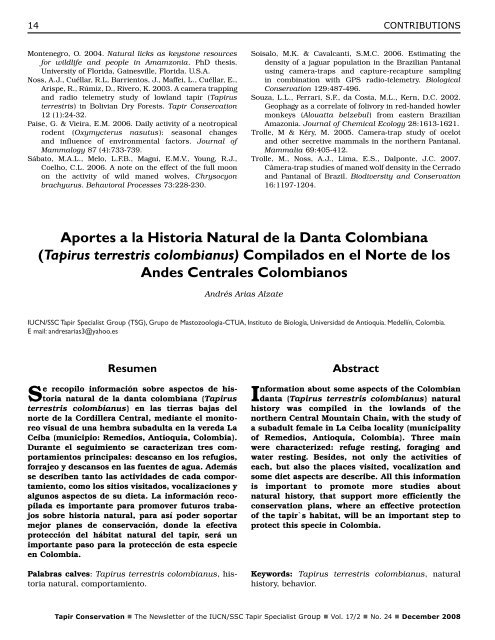Tapir Conservation - Tapir Specialist Group
Tapir Conservation - Tapir Specialist Group
Tapir Conservation - Tapir Specialist Group
Create successful ePaper yourself
Turn your PDF publications into a flip-book with our unique Google optimized e-Paper software.
14<br />
Montenegro, O. 2004. Natural licks as keystone resources<br />
for wildlife and people in Amamzonia. PhD thesis.<br />
University of Florida, Gainesville, Florida. U.S.A.<br />
Noss, A.J., Cuéllar, R.L, Barrientos, J., Maffei, L., Cuéllar, E.,<br />
Arispe, R., Rúmiz, D., Rivero, K. 2003. A camera trapping<br />
and radio telemetry study of lowland tapir (<strong>Tapir</strong>us<br />
terrestris) in Bolivian Dry Forests. <strong>Tapir</strong> <strong>Conservation</strong><br />
12 (1):24-32.<br />
Paise, G. & Vieira, E.M. 2006. Daily activity of a neotropical<br />
rodent (Oxymycterus nasutus): seasonal changes<br />
and influence of environmental factors. Journal of<br />
Mammalogy 87 (4):733-739.<br />
Sábato, M.A.L., Melo, L.F.B., Magni, E.M.V., Young, R.J.,<br />
Coelho, C.L. 2006. A note on the effect of the full moon<br />
on the activity of wild maned wolves, Chrysocyon<br />
brachyurus. Behavioral Processes 73:228-230.<br />
CONTRIBUTIONS<br />
Soisalo, M.K. & Cavalcanti, S.M.C. 2006. Estimating the<br />
density of a jaguar population in the Brazilian Pantanal<br />
using camera-traps and capture-recapture sampling<br />
in combination with GPS radio-telemetry. Biological<br />
<strong>Conservation</strong> 129:487-496.<br />
Souza, L.L., Ferrari, S.F., da Costa, M.L., Kern, D.C. 2002.<br />
Geophagy as a correlate of folivory in red-handed howler<br />
monkeys (Alouatta belzebul) from eastern Brazilian<br />
Amazonia. Journal of Chemical Ecology 28:1613-1621.<br />
Trolle, M & Kéry, M. 2005. Camera-trap study of ocelot<br />
and other secretive mammals in the northern Pantanal.<br />
Mammalia 69:405-412.<br />
Trolle, M., Noss, A.J., Lima, E.S., Dalponte, J.C. 2007.<br />
Câmera-trap studies of maned wolf density in the Cerrado<br />
and Pantanal of Brazil. Biodiversity and <strong>Conservation</strong><br />
16:1197-1204.<br />
Aportes a la Historia Natural de la Danta Colombiana<br />
(<strong>Tapir</strong>us terrestris colombianus) Compilados en el Norte de los<br />
Andes Centrales Colombianos<br />
Andrés Arias Alzate<br />
IUCN/SSC <strong>Tapir</strong> <strong>Specialist</strong> <strong>Group</strong> (TSG), Grupo de Mastozoologia-CTUA, Instituto de Biología, Universidad de Antioquia. Medellín, Colombia.<br />
E mail: andresarias3@yahoo.es<br />
Resumen<br />
Se recopilo información sobre aspectos de historia<br />
natural de la danta colombiana (<strong>Tapir</strong>us<br />
terrestris colombianus) en las tierras bajas del<br />
norte de la Cordillera Central, mediante el monitoreo<br />
visual de una hembra subadulta en la vereda La<br />
Ceiba (municipio: Remedios, Antioquia, Colombia).<br />
Durante el seguimiento se caracterizan tres comportamientos<br />
principales: descanso en los refugios,<br />
forrajeo y descansos en las fuentes de agua. Además<br />
se describen tanto las actividades de cada comportamiento,<br />
como los sitios visitados, vocalizaciones y<br />
algunos aspectos de su dieta. La información recopilada<br />
es importante para promover futuros trabajos<br />
sobre historia natural, para así poder soportar<br />
mejor planes de conservación, donde la efectiva<br />
protección del hábitat natural del tapir, será un<br />
importante paso para la protección de esta especie<br />
en Colombia.<br />
Palabras calves: <strong>Tapir</strong>us terrestris colombianus, historia<br />
natural, comportamiento.<br />
Abstract<br />
Information about some aspects of the Colombian<br />
danta (<strong>Tapir</strong>us terrestris colombianus) natural<br />
history was compiled in the lowlands of the<br />
northern Central Mountain Chain, with the study of<br />
a subadult female in La Ceiba locality (municipality<br />
of Remedios, Antioquia, Colombia). Three main<br />
were characterized: refuge resting, foraging and<br />
water resting. Besides, not only the activities of<br />
each, but also the places visited, vocalization and<br />
some diet aspects are describe. All this information<br />
is important to promote more studies about<br />
natural history, that support more efficiently the<br />
conservation plans, where an effective protection<br />
of the tapir`s habitat, will be an important step to<br />
protect this specie in Colombia.<br />
Keywords: <strong>Tapir</strong>us terrestris colombianus, natural<br />
history, behavior.<br />
<strong>Tapir</strong> <strong>Conservation</strong> n The Newsletter of the IUCN/SSC <strong>Tapir</strong> <strong>Specialist</strong> <strong>Group</strong> n Vol. 17/2 n No. 24 n December 2008










